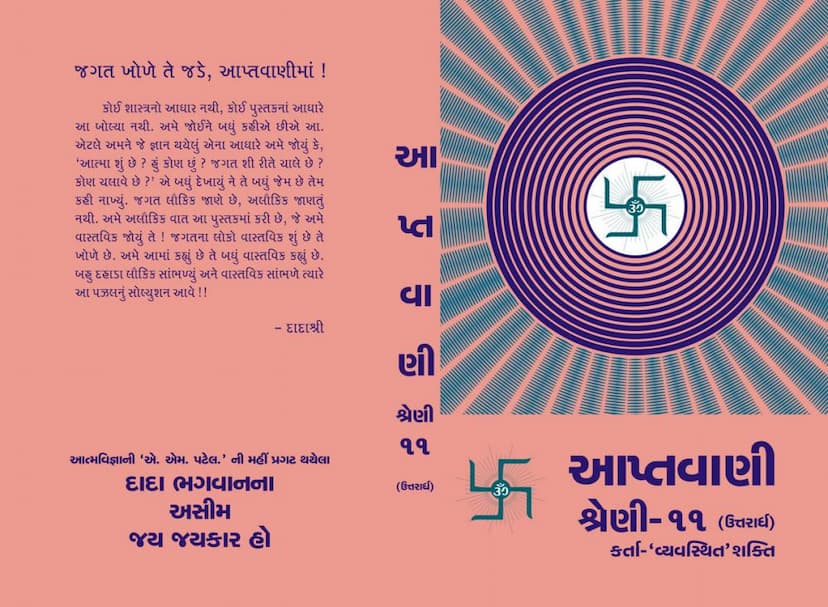Aptavani 11 U
Added to library: September 1, 2025

Summary
Here's a comprehensive summary of the Jain text "Aptavani 11 U" by Dada Bhagwan, based on the provided Gujarati text:
Aptavani 11 U: The Science of 'Vayavasthit' (The Orderly Arrangement of the Universe)
This book, Aptavani 11 U, is a collection of discourses by Dada Bhagwan, as channeled through A.M. Patel. It delves into profound spiritual concepts, primarily focusing on the 'Vayavasthit Shakti' (The Orderly Arrangement Power), which Dada Bhagwan describes as the scientific force that governs the universe. The text emphasizes that this knowledge is not based on any existing scriptures but on direct experiential realization.
Core Concepts:
- The Universe is Governed by 'Vayavasthit': The central theme is that the entire universe, from celestial bodies to individual lives, operates under a perfectly precise and scientific order called 'Vayavasthit'. Nothing happens by chance or independent will; everything is pre-ordained and perfectly arranged. This force is not God or any specific deity but an inherent, impersonal power.
- 'I Am Pure Soul', Not the Doer: After attaining Self-realization (Gnan Vidhi), one understands that they are the Pure Soul (Shuddhatma) and not the 'doer' of actions. The physical body and all its functions, including thoughts, speech, and actions, are carried out by 'Chandu-bhai' (the relative self/ego), who is also under the control of 'Vayavasthit'. The Pure Soul is merely an observer, a witness.
- Freedom from Attachment and Detachment: Understanding 'Vayavasthit' leads to freedom from attachment and aversion. When one realizes that they are not the doer, they are no longer affected by the consequences of actions (karma). They witness events unfold as 'Vayavasthit' dictates, remaining in a state of equanimity.
- 'Vayavasthit' as the Solution to Life's Puzzles: The knowledge of 'Vayavasthit' is presented as the solution to all of life's complexities, anxieties, and sufferings. It frees one from worry, tension, and agitation, leading to constant peace and contentment.
- Akram (Non-step) Path vs. Kramik (Step-by-step) Path: Dada Bhagwan contrasts the 'Akram' (non-step) path, which leads to immediate Self-realization and understanding of 'Vayavasthit', with the 'Kramik' (step-by-step) path, which involves gradual spiritual progress over many lifetimes. The Akram path bypasses the need for extensive austerities and efforts.
- The Role of 'Vayavasthit' in Daily Life: The book provides numerous practical examples of how 'Vayavasthit' operates in everyday situations:
- Accidents and Mishaps: Broken cups, lost belongings, or unexpected events are not attributed to personal carelessness or the actions of others but to 'Vayavasthit'.
- Success and Failure: Both favorable and unfavorable outcomes are orchestrated by 'Vayavasthit'.
- Health and Well-being: Even physical sensations and occurrences are part of this divine order.
- Relationships and Interactions: The people we meet and our interactions with them are all according to 'Vayavasthit'.
- Misuse of 'Vayavasthit' Knowledge: The text warns against misinterpreting 'Vayavasthit' as an excuse for inaction or laziness. While understanding that 'Vayavasthit' is in charge, one must still perform their duties without attachment or ego.
- The Importance of 'Jnaan' (Knowledge) and 'Soot' (Insight): The book emphasizes that true understanding comes from 'Jnaan' (Self-knowledge) and 'Soot' (insight), which leads to the correct application of the principles of 'Vayavasthit'.
- 'Vayavasthit' and Personal Effort: While 'Vayavasthit' governs events, it doesn't negate the need for personal effort within one's assigned role. However, the results of these efforts are governed by 'Vayavasthit'. The key is to perform actions without ego and with the understanding of 'Vayavasthit'.
- The Nature of 'Purusharth' (Self-effort) Post-Self-Realization: After Self-realization, the true 'Purusharth' lies in remaining in the Self (Shuddhatma) and witnessing the unfolding of 'Vayavasthit' without interference.
- Understanding 'Niyam' (Rules) vs. 'Vayavasthit' (Orderly Arrangement): The text clarifies that while there are universal laws ('Niyam'), 'Vayavasthit' is a more precise and individualized arrangement that accounts for the specific karmic accounts of each soul, leading to varied experiences even within the same overall order.
- The Ultimate Goal: Kevalgnan: The ultimate realization of 'Vayavasthit' leads to Kevalgnan (Omniscience), the state of complete knowledge.
Key Takeaways:
- Spiritual Freedom: The understanding and internalization of 'Vayavasthit' lead to freedom from suffering, worry, and ego.
- Inner Peace: By surrendering to the divine order and recognizing one's true Self as the Pure Soul, one attains lasting peace and bliss.
- Scientific Approach to Spirituality: Dada Bhagwan presents a highly scientific and experiential approach to spirituality, emphasizing direct experience and understanding over blind faith.
- Practical Application: The teachings are presented in a way that can be practically applied to overcome life's challenges and attain spiritual liberation.
In essence, Aptavani 11 U is a profound guide to understanding the intricate workings of the universe and finding liberation by recognizing oneself as the Pure Soul, the mere witness, within the perfectly orchestrated cosmic play of 'Vayavasthit'.